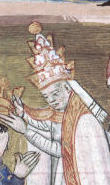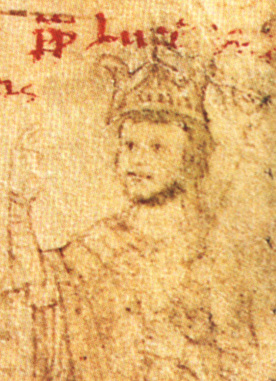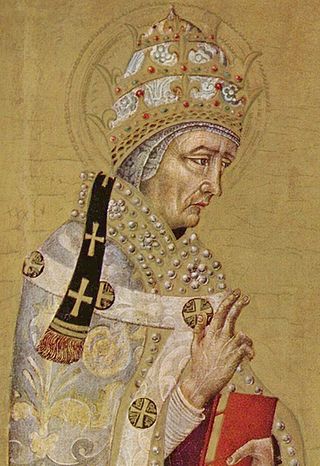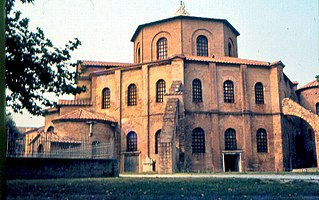Related Research Articles

Pope Adrian I was the bishop of Rome and ruler of the Papal States from 1 February 772 to his death. He was the son of Theodore, a Roman nobleman.
Pope Gregory II was the bishop of Rome from 19 May 715 to his death. His defiance of Emperor Leo III the Isaurian as a result of the iconoclastic controversy in the Eastern Empire prepared the way for a long series of revolts, schisms, and civil wars that eventually led to the establishment of the temporal power of the popes.
The 560s decade ran from January 1, 560, to December 31, 569.
The 570s decade ran from January 1, 570, to December 31, 579.

Year 561 (DLXI) was a common year starting on Saturday of the Julian calendar. The denomination 561 for this year has been used since the early medieval period, when the Anno Domini calendar era became the prevalent method in Europe for naming years.

Year 590 (DXC) was a common year starting on Sunday of the Julian calendar. The denomination 590 for this year has been used since the early medieval period, when the Anno Domini calendar era became the prevalent method in Europe for naming years.
Pope Leo II was the bishop of Rome from 17 August 682 to his death. He is one of the popes of the Byzantine Papacy. Described by a contemporary biographer as both just and learned, he is commemorated as a saint in the Roman Martyrology on 28 June.

Pope Lucius III, born Ubaldo Allucingoli, reigned from 1 September 1181 to his death in 1185. Born of an aristocratic family of Lucca, prior to being elected pope, he had a long career as a papal diplomat. His papacy was marked by conflicts with Holy Roman Emperor Frederick I, his exile from Rome and the initial preparations for the Third Crusade.
Pope Hormisdas was the bishop of Rome from 20 July 514 to his death. His papacy was dominated by the Acacian schism, started in 484 by Acacius of Constantinople's efforts to placate the Monophysites. His efforts to resolve this schism were successful, and on 28 March 519, the reunion between Constantinople and Rome was ratified in the cathedral of Constantinople before a large crowd.
Pope Pelagius I was the bishop of Rome from 556 to his death. A former apocrisiarius to Constantinople, Pelagius I was elected pope as the candidate of Emperor Justinian I, a designation not well received in the Western Church. Before his papacy, he opposed Justinian's efforts to condemn the "Three Chapters" in order to reconcile theological factions within the Church, but later adopted Justinian's position.
Pope Pelagius II was the bishop of Rome from 26 November 579 to his death.
Pope Severinus was the bishop of Rome elected in October 638. He was caught up in a power struggle with Emperor Heraclius, who pressured him to accept Monothelitism. Severinus refused, which for over eighteen months hindered his efforts to obtain imperial recognition of his election. His pontificate was finally sanctioned on 28 May 640, but he died two months later.
Pope John VI was the bishop of Rome from 30 October 701 to his death. John VI was a Greek from Ephesus who reigned during the Byzantine Papacy. His papacy was noted for military and political breakthroughs on the Italian Peninsula. He was succeeded by Pope John VII after a vacancy of less than two months. The body of the pope was buried in Old St. Peter's Basilica.
Pope Sisinnius was the bishop of Rome from 15 January 708 to his death on 4 February. Besides the fact that he was Syrian and his father was named John, little is known of Sisinnius' early life or career. At the time of his election to the papal throne, Sisinnius suffered from severe gout, leaving him weak. During the course of his twenty-day papacy, Sisinnius consecrated a bishop for Corsica and ordered the reinforcement of the walls surrounding the papal capital of Rome. On his death, Sisinnius was buried in Old St. Peter's Basilica. He was succeeded by Pope Constantine.

The Duchy of Spoleto was a Lombard territory founded about 570 in central Italy by the Lombard dux Faroald. Its capital was the city of Spoleto.

The Kingdom of Italy, also called Imperial Italy, was one of the constituent kingdoms of the Holy Roman Empire, along with the kingdoms of Germany, Bohemia, and Burgundy. It originally comprised large parts of northern and central Italy. Its original capital was Pavia until the 11th century.

The selection of the Pope, the Bishop of Rome and Supreme Pontiff of the Catholic Church, prior to the promulgation of In Nomine Domini in AD 1059 varied throughout history. Popes were often putatively appointed by their predecessors or by political rulers. While some kind of election often characterized the procedure, an election that included meaningful participation of the laity was rare, especially as the Popes' claims to temporal power solidified into the Papal States. The practice of Papal appointment during this period would later result in the putative jus exclusivae, i.e., the claimed but invalid right to veto the selection that Catholic monarchs exercised into the twentieth century.

In the 9th century, Christianity was spreading throughout Europe, being promoted especially in the Carolingian Empire, its eastern neighbours, Scandinavia, and northern Spain. In 800, Charlemagne was crowned as Holy Roman Emperor, which continued the Photian schism.

The Byzantine Papacy was a period of Byzantine domination of the Roman papacy from 537 to 752, when popes required the approval of the Byzantine Emperor for episcopal consecration, and many popes were chosen from the apocrisiarii or the inhabitants of Byzantine-ruled Greece, Syria, or Sicily. Justinian I reconquered the Italian peninsula in the Gothic War (535–554) and appointed the next three popes, a practice that would be continued by his successors and later be delegated to the Exarchate of Ravenna.

The Ostrogothic Papacy was a period from 493 to 537 where the papacy was strongly influenced by the Ostrogothic Kingdom, if the pope was not outright appointed by the Ostrogothic King. The selection and administration of popes during this period was strongly influenced by Theodoric the Great and his successors Athalaric and Theodahad. This period terminated with Justinian I's (re)conquest of Rome during the Gothic War (535–554), inaugurating the Byzantine Papacy (537–752).
References
- 1 2 Mann, Horace K. (1910). . In Herbermann, Charles (ed.). Catholic Encyclopedia . Vol. 8. New York: Robert Appleton Company.
- ↑ Martindale, John R.; Jones, A.H.M.; Morris, John (1992), The Prosopography of the Later Roman Empire – Volume III, AD 527–641, Cambridge University Press, ISBN 978-0-521-20160-5 , p. 61
- ↑ Jeffrey Richards, The Popes and the Papacy in the Early Middle Ages (London: Routledge and Kegan Paul, 1979), p. 256
- ↑ Historia Ecclesiastica 5.16
- ↑ Richards, Popes and the Papacy, pp. 162f
- 1 2 Richards, Popes and the papacy, pp. 164f